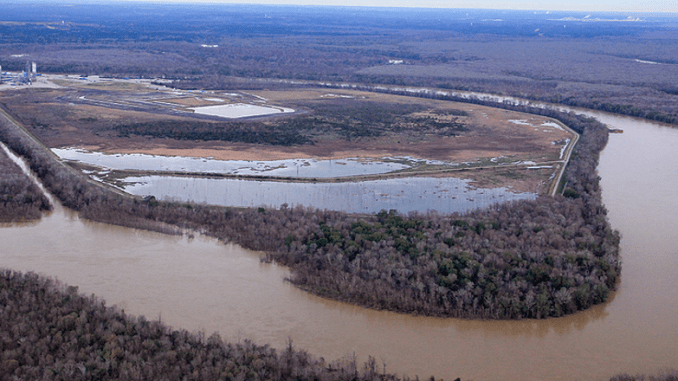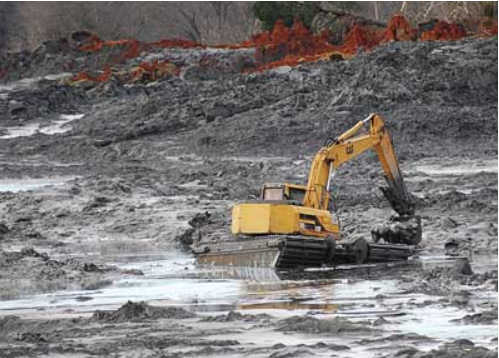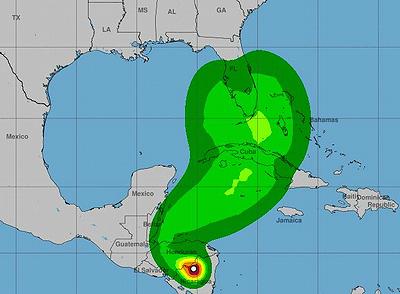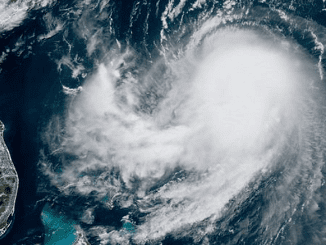
By Benjamin Seidman
BUCKS, Alabama, February 6, 2022 (ENS) – A new digital mapping tool shows that a Category 2 hurricane, packing winds up to 110 mph, could create a storm surge that sweeps more than 21 million tons of toxic coal ash from a power plant into the Mobile River, which empties into the Gulf of Mexico.
At the James M. Barry Electric Generating Plant in Bucks, Mobile County, Alabama, partly fired by coal, the coal ash left over is not secure but is exposed to storms. It lies in a 600-acre pond surrounded on three sides by the Mobile River with only an earthen dam to separate the river from the toxic ash.
Over the past 90 years, nine major hurricanes have struck Alabama and other Gulf Coast states, causing severe damage and death.
The precarious nature of Plant Barry’s coal ash pond comes into focus with the new “Changing Coasts” interactive mapping tool released online February 3 by the nonprofit and nonpartisan Southern Environmental Law Center.
Christopher DeScherer, who works with Southern Environmental Law Center, told ENS that this publicly available tool aims to, “pull together the critical data layers that you would want to look at all in one place in a user-friendly way, so that anybody with access to this site can quickly get their arms around proposed projects to see if they’re slated for construction in a place that’s ultimately vulnerable, and in a bad place for new infrastructure.”
Before 1970, coal ash was pumped into the atmosphere in dark, billowing clouds from coal plant smokestacks, but the Clean Air Act of 1970 put an end to this practice, which was replaced by the more discreet but also problematic practice of draining the coal ash into ponds.
The Barry Plant has been replacing old coal-fired units with natural gas. Five coal-fired units were replaced with natural gas in 2000. The plant now has nine units, seven gas and two coal and is generating less coal ash, but yesterday’s coal ash residue remains exposed in the pond.
Coal ash contains chemicals such as arsenic, mercury, cadmium, and radioactive elements such as uranium and thorium, posing dangerous health and ecological hazards.
- Ingesting high levels of arsenic can result in death. Exposure to lower levels can cause nausea, vomiting, decreased production of red and white blood cells, abnormal heart rhythm, damage to blood vessels, and the feeling of pins and needles in hands and feet, warns the U.S. Agency for Toxic Substances, ATSDR.
- Exposure to high levels of mercury can permanently damage the brain, kidneys, and a developing fetus.
- Breathing high levels of cadmium can damage the lungs. Lower levels of cadmium in air, food, or water can also cause lung damage, kidney disease and fragile bones.
- Uranium and thorium exposure can cause cancer.
A catastrophic failure of the earthen dam at the Barry Plant would impact the wetland and estuary downriver, polluting the Mobile River, Tensaw Delta, and Mobile Bay.
And a massive spill of coal ash would be tough to clean up. Coal ash is a fine sediment, so the toxic ash would spread out over surrounding lands and waters.

This happened during the Kingston Fossil Plant coal ash spill of 2008 when an embankment failed, spilling a mountain of coal ash into the Emory River in Tennesee. The cleanup effort took six years and cost over $1 billion.
More than 50 workers who assisted in the cleanup have died. Hundreds now suffer from chronic ailments, including cancers and lung disease linked to coal ash exposure. And the volume of the Kingston spill was just one-quarter of the amount of coal ash present at Plant Barry.
“We’ve got an A-bomb up the river,” John Howard, a fisherman from Mobile County, told CNN. “It’s just waiting to happen.”
The chance of storm surge waters getting into coal ash repositories everywhere is increasing. And in Alabama, with every passing year and every tropical storm, the chance of a spill or a catastrophic failure of the earthen dam holding back the coal ash at Plant Barry increase as the sea continues to creep up the Mobile River.
According to a report by Alabama Power, the utility that owns Plant Barry, 806 percent of the legal limit of arsenic is already contaminating groundwater next to the facility.
When it permanently closes the containment pond, Alabama Power plans to drain and then cover the unlined pond, leaving the coal ash right next to the Mobile River, a method of closure known as cap-in-place.
Many environmentalists say this is not enough protection because widespread contamination will continue. They worry that the heavy metals found in the coal ash will leach into the surrounding environment.
The Electric Power Research Institute warns, “Caps are not effective when coal ash is below the water table,” as it is at Plant Barry.
Due to this fact, Mobile Baykeeper, a nonprofit Mobile-based environmental group, is calling for the removal of the 21 tons of exposed coal ash from the plant to a safer, lined landfill facility.
“Alabama Power has refused to move the ash, or consider recycling it, citing that closing the pond in place is cheaper. This is unacceptable,” says Mobile BayKeeper, “especially when other utilities have proven that there are better, safer ways to store this toxic waste – away from water and in modern, lined landfills.”
The permit Alabama Power acquired from the state to cap-in-place the coal ash on site has not been approved by the U.S. Environmental Protection Agency.
“We understand the concerns about this facility in Alabama,” EPA Director Michael Regan told CNN in December. “The last administration’s leadership failed to act on these concerns. This administration will act to protect communities and, based on my prior experience, if there is coal ash in contact with groundwater, that’s putting the health and safety of communities at risk and requires our attention.”
The circumstances at Plant Barry show how unprepared southern infrastructure may be for sea-level rise. The sea level around Alabama is up to 11 inches higher than it was in 1966, according to the National Oceanic and Atmospheric Administration , NOAA.
This increase is mostly due to Alabama’s sinking land, and it is causing major issues, NOAA warns. The shorelines of the state’s barrier islands are receding by as much as 12 feet a year and important habitats are disappearing.
As the sea level rises, it makes existing coastal flooding more severe and erodes beaches, eventually submerging wetlands, dry land and unprotected coal ash ponds.
Featured image: The James M. Barry Electric Generating Plant in Mobile County, Alabama lies on the west bank of the Mobile River, using the river both for coal delivery and for cooling water. (Photo courtesy Alabama Power)



